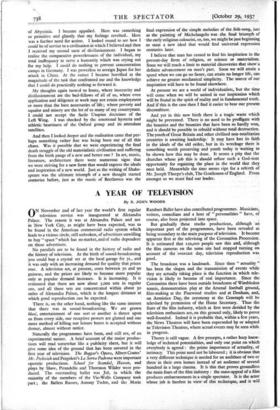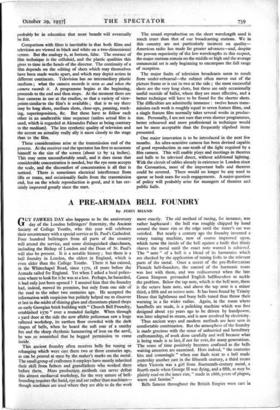A YEAR OF TELEVISION
By S. JOHN WOODS
ON November and of last year the world's first regular television service was inaugurated at Alexandra Palace. The reason it was at Alexandra Palace and not in New York City, as might have been expected, was to be found in the American commercial radio system which leads to a vicious circle, still unbroken, of advertisers unwilling to buy " space "which has no market, and of radio dependent on those advertisers.
No parallels are to be found in the history of radio and the history of television. At the birth of sound-broadcasting you could buy a crystal set at the local garage for 5s., and it was only with an increasing demand for quality that prices rose. A television set, at present, costs between so and 90 guineas, and the prices are likely to become more popular only as popular demand increases. It is increasing. It is estimated that there are now about 5,000 sets in regular use, and all those sets are concentrated within about 30 miles of Alexandra Palace, which is the longest distance at which good reproduction can be expected.
There is, on the other hand, nothing lilte the same interest that there was in sound-broadcasting. We are grown blasé, entertainment of one sort or another is thrust upon us from every side, our receptive powers are glutted and one more method of killing our leisure hours is accepted without demur, almost without notice.
Naturally the programmes have been, and still are, of an experimental nature. A brief account of the major produc- tions will read somewhat like a publicity sheet, but it will give some idea of the ground that has been covered in the first year of television. The Beggar's Opera, Albert Coates' Mr. Pickwick and Pergolesi's La Serva Padrona were important operatic productions. School for Scandal, Hassan, and plays by Shaw, Pirandello and Thornton Wilder were pro- duced. The outstanding ballet was yob, in which the majority of the members of the Vie-Wells Company took part ; the Ballets Russes, Antony Tudor, and the Marie Rambert Ballet have also contributed programmes. Musicians, writers, comedians and a host of " personalities " have, of course, also been projected into space.
But gradually these studio productions, although an important part of the programmes, have been revealed as being secondary to the main purpose of television. It became apparent first at the televising of the Coronation Procession. It is estimated that 120,000 people saw this and, although the film cameras on the same site had stopped turning on account of the 'overcast day, television reproduction was good.
The broadcast was a landmark. Since then " actuality " has been the slogan and the transmission of events while they are actually taking place is the function in which tele- vision is likely to become of real importance. Since the Coronation there have been outside broadcasts of Wimbledon tennis, demonstration play at the Arsenal football ground, film-making at the Pinewood studios and at Denham, and, on Armistice Day, the ceremony at the Cenotaph will be televised by permission of the Home Secretary. Thus the fears of the film industry, which at first were derided by the television enthusiasts are, on this ground only, likely to prove well-founded. Indeed it is probable that, within a few years, the News Theatres will have been superseded by or adapted to Television Theatres, where actual events may be seen while in progress.
Theory is still vague. A few precepts, a rather hazy know-. ledge of technical potentialities, and only one point on which everybody is agreed : the prime importance of actuality, of intimacy. This point need not be laboured ; it is obvious that a very different technique is needed for an audience of two or three in their own homes instead of an audience of several hundred in a large cinema. It is this that proves groundless the main fears of the film industry : the mass-appeal of a film produces embarrassment in a single spectator. It is the actor whose job is hardest in view of this technique, and it will probably be in education that most benefit will eventually be felt.
Comparison with films is inevitable in that both films and television are viewed in black and white on a two-dimensional screen. But the analogy is, at bottom, false. The essence of film technique is the celluloid, and the plastic qualities this gives to time in the hands of the director. The continuity of a film depends on the editing of shots which may themselves have been made weeks apart, and which may depict action in different continents. Television has no intermediary plastic medium ; what the camera records is seen as and when the camera records it. A programme begins at the beginning, proceeds to the end and then stops. At the moment there are four cameras in use at the studios, so that a variety of view- points similar to the film's is available ; that is to say there may be long shots, medium shots, close-ups, panning, track- ing, superimposition, &c. But these have to follow each other in an unalterable time sequence (unless actual film is used, which is regarded at Alexandra Palace as being contrary to the medium). The less synthetic quality of television and the accent on actuality really ally it more closely to the stage than to the film.
These considerations arise at the transmission end of the process. At the receiver end the spectator has first to accustom himself to the size of the screen (about 12 by 14 inches). This may seem uncomfortably small, and it does mean that considerable concentration is needed, but the eye soon accepts the scale, and the discomfort of concentration is all that is noticed. There is sometimes electrical interference from lifts or trams, and occasionally faults from the transmission end, but on the whole reproduction is good, and it has cer- tainly improved greatly since the start. The sound reproduction on the short wavelength used is much truer than that of our broadcasting stations. We in this - country are not particularly insistent on quality— American radio has made far greater advances—and, despite the proven superiority of the low wavelengths in this respect, the major stations remain on the middle or high and the average commercial set is only beginning to encompass the full range of reception.
The major faults of television broadcasts seem to result from under-rehearsal--the subject often moves out of the picture frame or is cut in two at the side ; the most successful shots are the very long shots, but these are only occasionally useful outside of ballet, where they are most effective, and a better technique will have to be found for the shorter shots. The difficulties are admittedly immense : twelve hours trans- mission each week is roughly equal to seven feature films, and a single feature film normally takes several weeks in produc- tion. Personally, I am not sure that even shorter programmes, better rehearsed and more professional in technique would not be more acceptable than the frequently slipshod items presented.
One major innovation is to be introduced in the next few months. An ultra-sensitive camera has been devised capable of good reproduction in one-tenth of the light required by a film camera. This will enable plays and meetings in theatres and halls to be televised direct, without additional lighting. With the circuit of cables already in existence in London since the Coronation, most of the important halls and theatres could be covered. There would no longer be any need to queue or book seats for such engagements. A major question of policy will probably arise for managers of theatres and public halls.



























































 Previous page
Previous page